NVIDIA’s GeForce GTS 450: Pushing Fermi In To The Mainstream
by Ryan Smith on September 13, 2010 12:02 AM EST- Posted in
- NVIDIA
- Fermi
- GeForce GTS 450
- GF106
- GPUs
Overclocking
As we alluded to in the opening of this article, NVIDIA is once again pushing the overclockability of their GPUs. The GF106 GPU at the heart of the GTS 450 is supposed to be about as overclockable as the GF104 GPU instead the GTX 460, and there’s little doubt that this is the case. NVIDIA’s partners are already on the bandwagon, and are offering heavily overclocked cards. Or for the do-it-yourself types, even the average reference card should be quite overclockable as long as you’re willing to take the risk of the periodic dud.
The GTS 450 is already supported by the latest version of MSI’s excellent afterburner software, and keeping with their policy MSI has enabled overvoltage support for all cards using the same VRMs as the reference card. So we were able to overvolt all of our reference cards and our factory overclocked cards. The VRMs on all of the cards except the Asus card top out at 1.162v, however for safety reasons (and the fact that the VRMs aren’t even passively cooled) we limited ourselves to 1.15v.
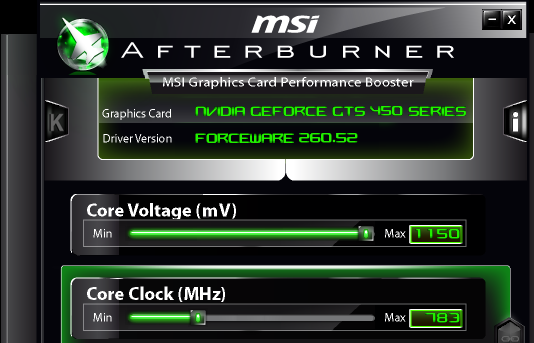
As not all of our cards are exactly alike, we’ll quickly run down the differences between the various cards
- 2x NVIDIA GTS 450 Reference
- 1x Calibre X450G. Reference PCB, aftermarker cooler, factory overclocked
- 1x EVGA GTS 450 FTW. Reference PCB, reference cooler, factory overclocked
- 1x Asus ENGTS450 TOP. Reference-derived PCB, custom cooler, factory overclocked
- 1x Palit GeForce GTS 450 Sonic Platinum. Custom PCB, custom cooler, factory overclocked
| Overclocking Results | ||||||
| Stock Clock | Max Overclock | Stock Voltage | Overclocked Voltage | |||
| GTS 450 Reference #1 | 783MHz | 955MHz | 1.05v | 1.115v | ||
| GTS 450 Reference #2 | 783MHz | 930MHz | 1.062v | 1.115v | ||
| Asus ENGTS450 Top | 925MHz | 985MHz | 1.125v | 1.115v | ||
| EVGA GTS 450 FTW | 920MHz | 955MHz | 1.112v | 1.115v | ||
| Palit GTS 450 Sonic Platinum | 930MHz | 985MHz | 1.087v | 1.115v | ||
| Sparkle Calibre X450G | 850MHz | 935MHz | 1.087v | 1.115v | ||
Unlike the GTX 460 launch where the vendor cards we had all came with a mild factory overclock, for the GTS 450 launch all of our cards have a significant factory overclock. 3 of the 4 are at 920MHz or better, which is a 137MHz (17%) overclock over reference speeds.
Even with voltage tweaking capabilities there was a very noticeable range in the overclockability of our cards. The worst card was one of the reference cards, which only hit 930MHz even at 1.15v. The best cards were the Asus and Palit cards at 985MHz. This puts the average overclock at just over 955MHz, which isn’t too far off from the factory overclocks already on some of these cards.
Meanwhile 4.2GHz seems to be the wall for memory overclocking. The GTS 450 is only equipped with 4GHZ GDDR5, so this may not be a fantastic outcome but it is realistic.

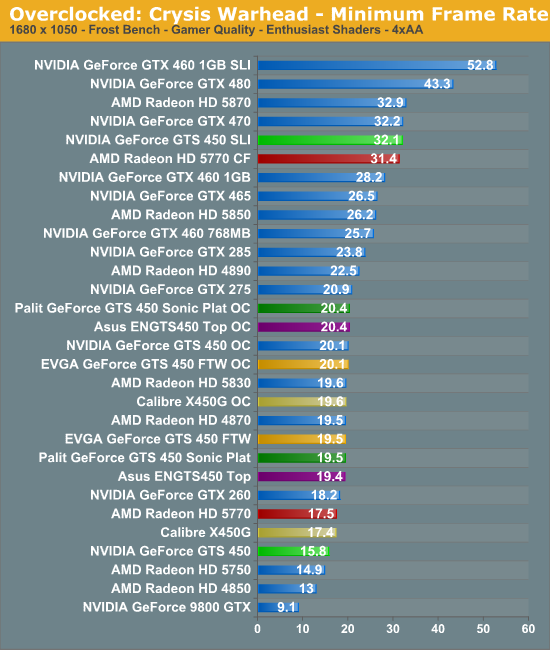
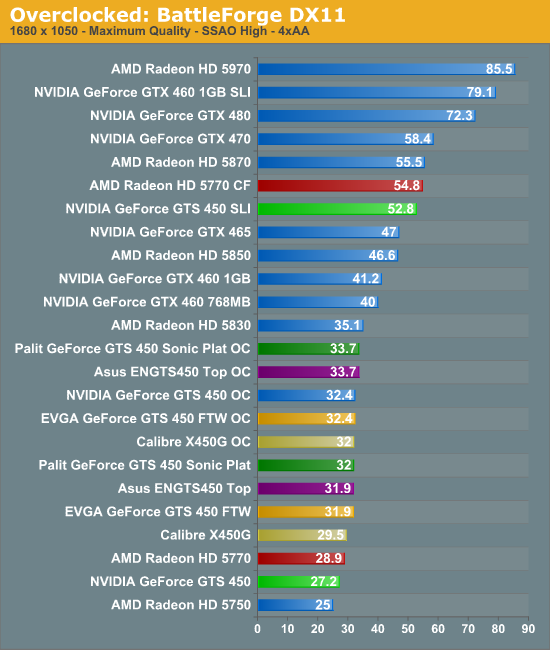
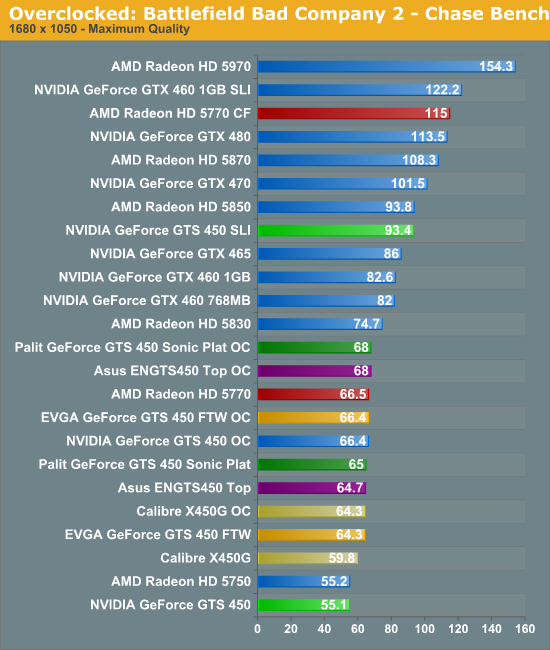
Because our maximum overclocks weren’t too much higher than the factory overclocks on some of these cards, there aren’t many surprises to be had when it comes to overclocking. With a solid overclock you can beat the 5770 most of the time, but it’s not enough to get much higher than that.
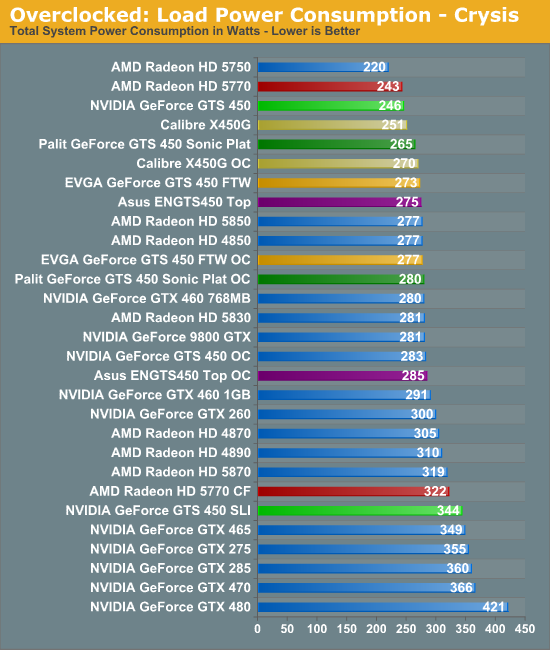
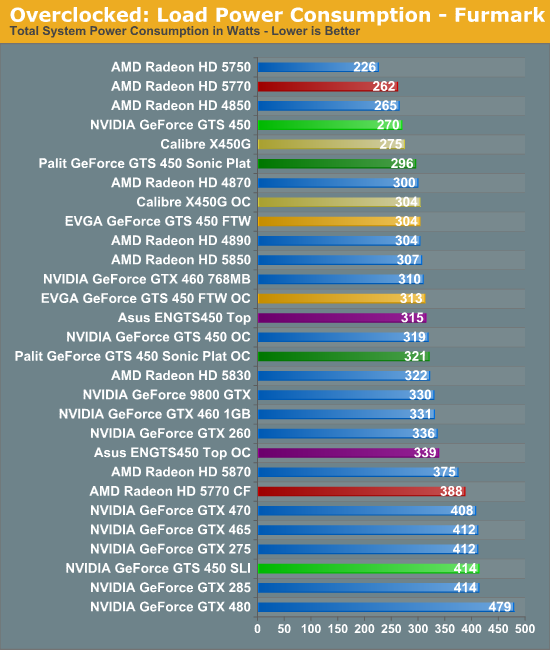

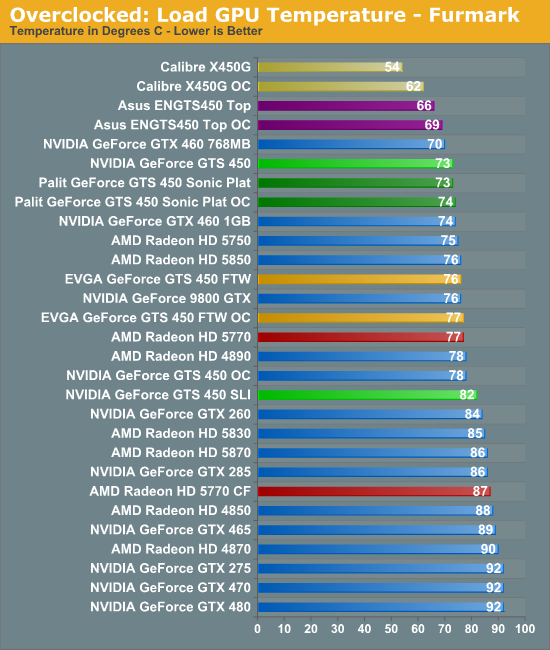

Overclocking (or rather overvolting) has the usual outcome when we look at power, temperature, and noise. The extra power enables extra performance, but it completely blows the performance-per-watt of the GTS 450 cards. Temperature and noise levels rise, but both are actually still quite manageable even at 1.15v. The only things holding the GPU back are the VRMs feeding it, and the innate limits of what the GPU can reach. Given this, it makes little sense not to overclock as long as you have a card with a suitable limit.
Finally, as a testament to how poorly a pair of GTS 450s in SLI get along with each other when they’re right next to each other, we weren’t able to get away with overvolting them at all. Even at 1.1v, the covered card would ultimately reach a thermal runaway under FurMark – the fan would max out and the temperature would start climbing in to the 90s. This shouldn’t be an issue with cards that are separated, but overclocking is definitely not on the menu when they’re packed together.










66 Comments
View All Comments
just4U - Monday, September 13, 2010 - link
Here in Canada I haven't really seen any 5850's priced under 300 yet and most are up in the 330 range.. The 1G 460 sit's in the 220-240 (no price drops for us) so it's a tempting alternative for many (I think)I also believe the 5850 will be a $200 card sometime in the near future. It's been selling way above it's suggested retail price (at launch) and when that happens it will be harder to consider the 460 as a viable alternative. I can't see it being sold at $150 (for the 1G variants) any time soon... so only fan's of Nvidia would consider it if it's priced in the 5850s range.
jabber - Monday, September 13, 2010 - link
Big thing is...who actually bought a 5830?When it came out everyone said it was a pointless card so big whoop, Nvidia's 460 beats a card that should never have been released in the first place.
Bit like saying "our car out performed the Ford Edsel!"
If you want middle of the road performance you get a 5770, if you want a better boost you get the 5850.
just4U - Monday, September 13, 2010 - link
It was only a pointless card because of it's price... Originally it should have been alot cheaper but supply and demand has inflated the prices of most of Amd's 5X lineup. Sitting near a $100 more then the 5770 is what made it a hard sell.erple2 - Wednesday, September 15, 2010 - link
Sure it did - the 768MB version fo the 460 now gave you 5830 performance for > 10% less money. To me, that makes it sound like the 5830 was now "obsoleted" by the 460 series. The 1 GB card was significantly faster at the same price point, and the 768 MB version was just as fast, but significantly cheaper. Both using less power, noise and heat.Isn't that essentially what defines "obsoletes"?
SandmanWN - Monday, September 13, 2010 - link
Throughout the entire test suite the 5850 is within 4-6 frames of the 470. In two it makes it to 8 and 10 frames more. Given you need an extra 100W's on your power supply and the additional cost associated with that just to get that tiny fraction of output, the statement seems fanboyish. AT should be better than this.just4U - Monday, September 13, 2010 - link
What does the 470 have to do with this? Most of us all agree that the 465/470/480 are all heat scores with insane power draws.. the 460 addressed that and came in at a price point that hit a sweet spot.. bringing alot of the 470/480's strengths and none of it's weaknesses to the table. Only real complaint I've seen for the 460 is the mini hdmi.IceDread - Tuesday, September 14, 2010 - link
You are missing my point.By saying "and it struck beautifully" implies that you are cheering for the nvidia team. It would be a different thing if he wrote "and it struck hard" or something like that.
adonn78 - Monday, September 13, 2010 - link
I read another review, damn my cheating heart. That stated the SLI scalling ont hese cards were impressive. You got 2 GTS 450 cards but no SLI?Stuka87 - Monday, September 13, 2010 - link
Er, every single benchmark shows the GTS-450 SLI scores. They are marked in green (like the regular GTS-450).marraco - Monday, September 13, 2010 - link
Other web sites show that the 450 is slower than the 250.It's strange when the 250 has 128 shaders, and the 450 has 192.... and the 450 has DDR5 vs DDR3 in the 250.
It looks like the texture units bottleneck this design.
Even more strange is that I could not find the 250 on this article charts.
I don't see the 450 as price competitive with the radeons, except as SLI setup. It would be more valuable if 3-SLI way were allowed, and I guess that is not the case, because the photos shown only a single SLI connector.
The SLI setups are unbeatable against the radeons price/performance. Maybe nVidia should design cheap, energy-efficient chips so a card manufacturer can pack 10 video chips on a single card.